
The Horticulture Industry in Bangladesh: Sowing the Seeds for a Prosperous Agricultural Landscape
Written By Syed Md. Rakeen
Home to many lush greeneries on the outskirts of Dhaka, Bangladesh boasts a strong agricultural foundation with a large scale of high-value crop production annually. Such has been the instrumental role of agriculture in terms of food security that horticulture has only risen in prominence over the years. The term ‘horticulture’ refers to the small-scale production of crops in greenhouses or formal flower beds, usually in an enclosed gardening system for growing edible and non-edible plants. Unlike most large arable lands where agricultural practices are employed, horticulture takes up less space and garners a much higher per-hectare benefit when compared to agricultural practices. In order to mimic arable land, scientific methods and technologies are used to maximise crop yield. This, in turn, leads to an increased supply of horticulture products, which can then be sold to farmers. Horticultural farming accounts for 7% of the total crop production, utilising 4% of the total farming area in the process.
Promising Outlook of the Industry
From a geographical perspective, South Asia possesses quite a diverse agro-climatic environment, which provides an excellent culture for the cultivation of horticultural crops. Generally, SAARC countries boast myriads of indigenous vegetables, fruits, flowers, spices, plantation crops, and herbs commonly used for therapeutic or medicinal purposes. The prospective landscape of horticulture in Bangladesh can be attributed to climate and regional variations, which have led to an increase in horticultural crops like fruits, vegetables, potatoes, tropical tuber crops, mushrooms, ornamental, medicinal, and aromatic plants, plantation crops, and spices. Agro-horticultural crops play a crucial role in poverty alleviation, employment creation, and food security. Generally, there are three productive seasons for crops where the cultivation of vegetables is intensified in two particular seasons, namely summer and winter (rabi). While summer production poses significant challenges for farmers due to heavy rainfall and an increasing number of pests and diseases, the prices of crops increase sharply, leading to a huge influx of profits. Horticulture produce is perceived to be more profitable as it can garner huge market prices compared to staple goods such as rice. In the fiscal year 2022–23, the contribution of crops and horticulture to Bangladesh’s GDP stood around BDT 236,869 crore, experiencing a 10% rise from the fiscal year 2021–22, when the figures were BDT 215,365 crore.

Exploring the Horticulture Value Chain
In Bangladesh, the value chains of horticulture involve different types of middlemen, namely local traders (forias), commission agents (aratdars), wholesalers, and retailers. Farmers sell their produce to consumers or local traders at domestic markets or bring it to wholesale markets. At times, farmers strike deals with forias, aratdars, and wholesalers regarding the sales of fruits and vegetables from fruit orchards and vegetable fields, respectively, in return for obtaining loans. Once the produce is sold to the forias, fruits and vegetables are then organised through assembling, sorting, grading, and cleaning before reaching the hands of the aratdars. The aratdars are responsible for arranging or negotiating the sales or fixing the commissions of sellers. They play the role of wholesalers and establish wholesale shops of their own. The wholesalers purchase the produce from the aratdars in a wholesale market and then sell it to the retailers. Then, the retailers sell the horticultural produce to consumers at retail stores or street vendors.
The flourishing supermarket business has facilitated the demand for fruits and vegetables. These products are sourced from some wholesale markets or farmers through contract farming. Despite a small market share in the fruits and vegetables category, local retail companies have expanded their operations via their own supermarkets.
Open trucks are the most common mode of fresh produce transportation. As trucks are generally filled with various products, the produce tends to lose its quality, leading to spoilage. The usage of cold storage is growing but is still quite minimal. In the majority of cases, they are owned by aratdars and used for selected horticultural produce such as potatoes, spices, and imported fruits. As per the Bangladesh Cold Storage Association, there are 428 cold storages in the country with an approximate 5.5 million metric tonnes as of 2019.
As per Growth Market Reports, the global horticulture market size was USD 22.42 billion in 2022 and is expected to reach USD 52.43 billion by 2031, expanding at a compound annual growth rate of 9.9% during 2023–2031. Currently, Bangladesh is already exporting to about 40 countries in the world, with the majority of the markets in Saudi Arabia, Qatar, Kuwait, the UK, and Malaysia for diaspora markets. Exports fluctuate frequently due to issues with the quality control of horticultural produce. Several export shipments are declined owing to contamination and failure to meet standards, leading to a great dearth of infrastructure and logistics required to build an efficient export channel.
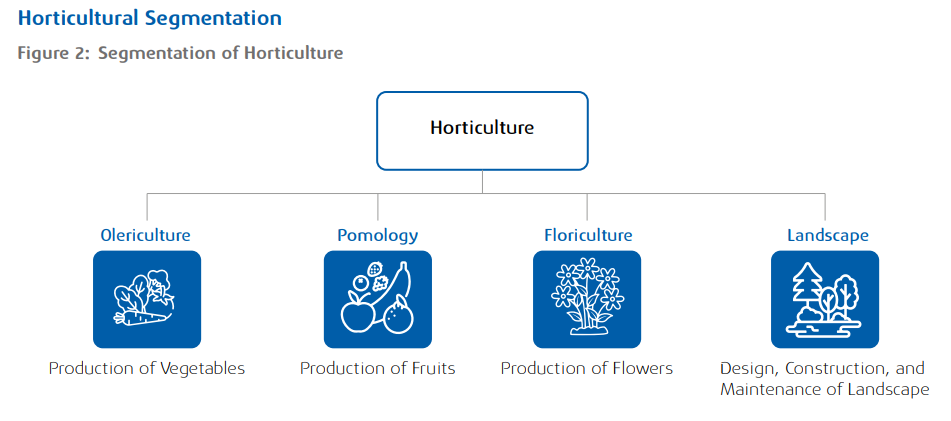
Olericulture
Olericulture refers to that branch of horticulture that consists of vegetable and herb production in Bangladesh. In the last few decades, vegetable production has experienced a growing popularity due to its consumption by a massive population, inevitably creating a huge local market, export- oriented markets, and local processing demand. For commercial and semi-commercial farmers in Bangladesh, vegetables are considered the pick of the bunch for crop cultivation.
With a production capacity of over 150 vegetable crops, the essential vegetables are considered to be onion, garlic, tomato, brinjal, cauliflower, gourd, chilli, and cabbage. Consulting, Resilience and Edge Consulting revealed that the annual production of vegetables totals over 6.5 million tonnes, of which 1.9 million tonnes are summer vegetables, 2.5 million tonnes are winter vegetables, 1.8 million tonnes are onion, and 466 thousand tonnes are garlic. In Bangladesh, potato is also a major horticultural crop. The production of such vegetables is scattered throughout the country, although there are major producing regions in southern and northern Bangladesh, namely Jashore to the north-west part of Bangladesh called Rangpur and Jamalpur.
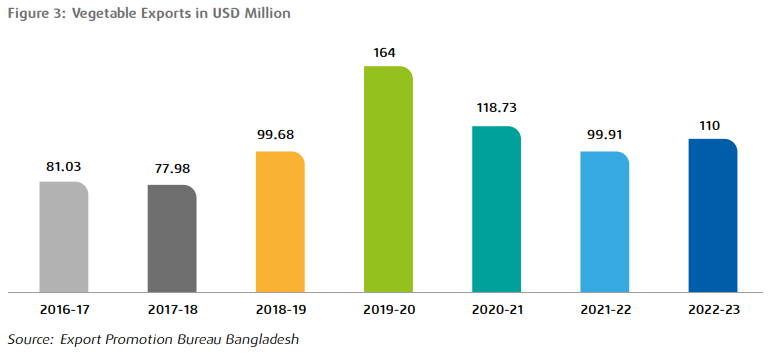
Floriculture
Floriculture deals with the production of field-grown or greenhouse-grown plants for their flowers or showy leaves. The increasing demand for flowers in Bangladesh has helped the floriculture industry to thrive, leading to increased commercial cultivation of flowers. According to the Business Post, in 2022, the floriculture industry registered an impressive annual growth rate of 10%–15%. The Horticulture Foundation, a state-run organisation, reported that the domestic flower and foliage sector is currently experiencing an annual turnover of BDT 1,600 crore. The current industry landscape is a stark contrast to a decade and a half ago, when Bangladesh relied heavily on flower imports to meet 80% of its local demand. According to the Bangladesh Flower Society, Bangladesh now meets 95% of the domestic demand through local production, with the remaining 5% of the demand being met from India, China, and Malaysia. Domestic flowers experienced a surge in demand in the global market, primarily in Europe and the Middle East. The export categories of flowers include tuberose and gladiolus in Saudi Arabia, Pakistan, the UK, Belgium, Canada, Germany, India, Italy, and the UAE, among other countries.
Pomology
Pomology is concerned with the cultivation, production, harvest, and storage of horticultural fruits. Successful commercial farming has led to massive fruit production in Bangladesh during the last 20 years. With an average annual rise in fruit output of 11.5% for the previous 18 years, Bangladesh ranks among the top 10 tropical fruit-producing nations in the world, according to the Food and Agriculture Organisation (FAO) of the United Nations. Local fruit production has experienced significant expansion in the commercial sector between 2013–14 and 2021– 2022. Fruits grown on a large scale include java plum (jaam), litchi, jujube, star fruit (kamranga), wood apple, lemon, pineapple, lotkon (Burmese grape), custard apple, and sapodilla (safeda). Over the past ten years, Bangladesh has evolved from producing 56 to 72 different fruit kinds, according to the Ministry of Agriculture.
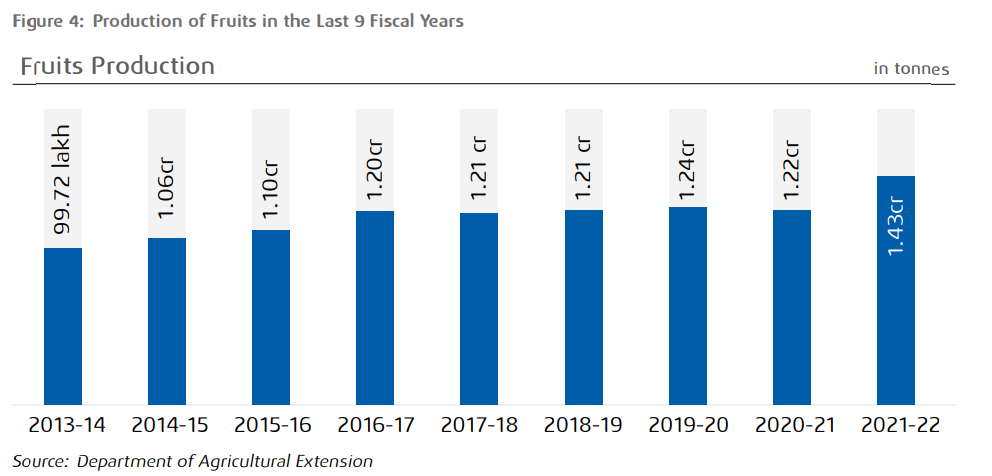
Landscape
Horticulture The area of horticulture that deals with growing plants for decorative purposes in both indoor and outdoor environments by harbouring a natural environment is known as landscape or environmental horticulture. Landscapes are of two varieties, namely, natural and artificial landscapes. The natural landscape is immune to human activities and remains strong, provided the living and non-living natural environment can move freely. Artificial landscape refers to artificially created plants for landscaping an outdoor environment. Its benefits reside in its minimal maintenance.
Market-Oriented Greenhouses Private Companies
A study found that there are several greenhouses that are already established, including the likes of Paramount Agro, Farm Fresh Organics, Shourov Fisheries and Agro, Paragon Agro, Square Food & Beverage, and Tamishna Group. Greenhouse produce often rivals imported vegetables and domestically grown crops in Dhaka by competing in the niche segment of high-value crops. Although competition exists, greenhouse produce possesses a lot of demand, with market players predicting the sector to expand. Greenhouses prefer direct online sales, sales to supermarkets, and, at times, sales to the local premium markets for commercial sales. The marketing efforts are customised and generally vary according to the locations
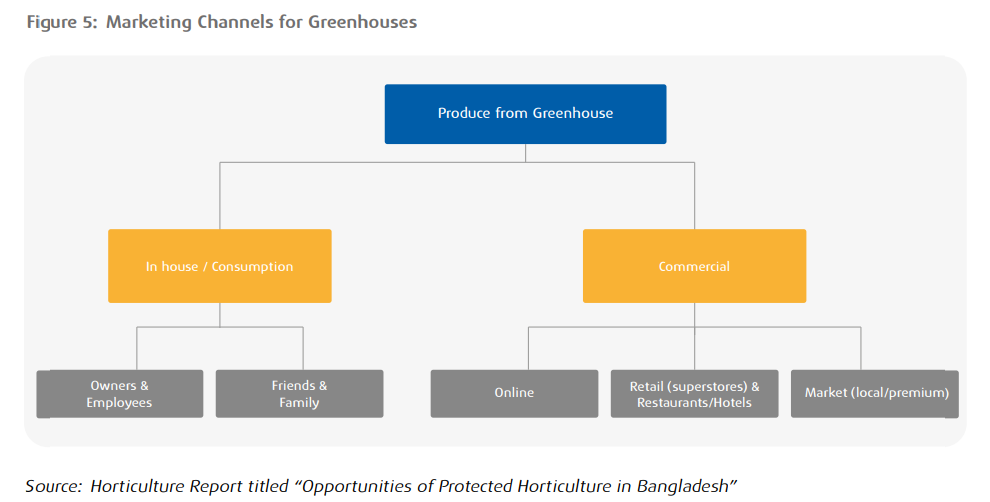

Research Centres in Bangladesh
According to agro Bangladesh a total of five horticulture research centres are up and running under BARI at Joydebpur, Rahmatpur (Barisal), Hathazari (Chittagong), Akbarpur (Moulvibazar), and Nababgonj (Rajshahi). These research centres currently deal with a huge volume of research programmes related to fruits, vegetables, and spices to elevate the current production technologies of farmers’ and meet their needs, enabling them to utilise natural resources and maximise the production of their horticulture produce.
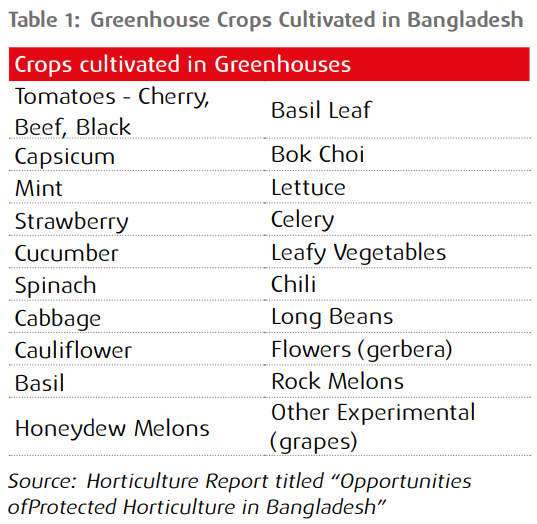
Existing Obstacles in Horticulture Practices
Despite the promise of massive yield per hectare of area relative to agriculture, the implementation of proper horticulture practices can be difficult in terms of execution. For greenhouse-based companies, the cultivation process can be quite challenging, as the cultivation process is reliant on the solution used in the case of nutrition sources for plants or fertilizers. These chemicals are not recognised by authorities as agriculture-friendly chemicals with no HS codes on them, leading to heavy taxes during industrial usage.
Seeds for indoor cultivation with large yields are crucial to this sector. However, there are not many recognised seed suppliers in Bangladesh. This creates a situation where businesses are forced to source seeds from certain indoor seed suppliers. Inefficient cultivation practices have also largely hindered the growth of this industry, while natural calamities and poor production planning have disrupted supply chains. Lastly, despite the escalating demand for horticulture produce, farmers’ share in the consumer price is extremely low owing to the long list of middlemen that exists, preventing farmers from getting their deserved shares.
In spite of Bangladesh’s large population, shrinking arable land, and frequent natural disasters, the country has made significant progress in achieving self-sufficiency for the production of agricultural crops and reducing poverty. The farming sector now employs almost half of the population. Hence, the interests of this sector must therefore be taken into account in national policies, especially at a time when the country faces many challenges as a nation. The country will continue to move forward, and the agricultural sector will thrive if marginal farmers can be protected and new technologies are put in place. Besides, the government had already outlined a list of plans for the enhancement of the agriculture sector, namely the National Agricultural Policy 2018, the 8th Five-Year Plan, Vision 2041, Sustainable Development Goals, Delta Plan-2100, etc. While the policies are conducive to fostering the horticultural industry, the large-scale implementation of horticultural practices is still in progress.


Rechanneling Insurance: Dawning an Era of Bancassurance in Bangladesh
Bancassurance, the strategic collaboration between banks and insurance companies, is set to bolster the largely untapped insurance industry in Bangladesh. Prominent in Europe and some parts of Asia, bancassurance is defined as the symbiotic relationship between banks and insurance companies, where banks receive a commission for opening an avenue for selling insurance policies while insurance companies gain access to a massive network of clients through banking channels. With a penetration rate of a mere 0.5% and a market size of BDT 5,000 crore in Bangladesh, this synergy can serve as a powerful tool for increasing insurance penetration and financial inclusion in Bangladesh.
Developing economies necessitate the demand for insurance, with higher incomes translating to an increased insured population. Gradually, as more and more people avail of insurance policies and bring themselves under insurance channels, the premium size is likely to experience a decline and become affordable to the mass population.
The inadequate claims settlement ratio has held back the insurance penetration rate in Bangladesh to a large extent. Delays in settling claims after policy maturity, insufficient returns due to inadequate fund investment, and financial irregularities pose significant challenges for insurance companies. However, the handshake through bancassurance between banks and insurance companies is expected to foster a conducive environment and bring the uninsured population under the insurance umbrella, resulting in numerous opportunities.
Md. Shah Jalal
Editor
IDLC Monthly Business Review
Download View